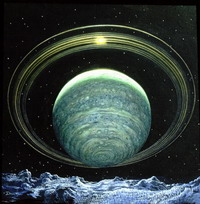Login form
Uranus
 There are no cars on the planet Uranus. Yet Uranus is covered with a kind of smog. Smog on Earth is pollution that comes mostly from cars that burn gasoline. Sunlight changes fumes from the cars to smog.
There are no cars on the planet Uranus. Yet Uranus is covered with a kind of smog. Smog on Earth is pollution that comes mostly from cars that burn gasoline. Sunlight changes fumes from the cars to smog.
Smog on Uranus comes from gases called ethane and methane. Small amounts of these gases are part of the atmosphere of Uranus. An atmosphere is the layer of gases around a planet, like air on Earth. Sunlight shining on methane and ethane makes smog. The haze of smog around Uranus makes the planet look like a smooth, bluish-green beach ball.
WHO DISCOVERED URANUS?
Uranus was the first planet discovered with a telescope. William Herschel, an astronomer in England, found Uranus in 1781. Astronomers are scientists who study things in space. Astronomers had known about Uranus since 1690, but they did not know Uranus was a planet. At first, they thought it was a star or a comet. Astronomers named the planet Uranus for an ancient Greek god of the heavens.
WHAT IS IT LIKE ON URANUS?
Uranus is a huge planet. It is the third largest planet in the solar system, after Jupiter and Saturn. The diameter (width) of Uranus is more than four times bigger than the diameter of Earth.
You could not walk around on Uranus. Uranus does not have a solid surface. The planet is made up mostly of gas. It has clouds made of methane ice high in the atmosphere. The clouds get thicker and thicker the farther down you go.
The thick clouds blend into a liquid ocean. Astronomers think the ocean on Uranus is made of water and the chemicals ammonia and methane.
THE ATMOSPHERE OF URANUS
You could not breathe on Uranus. The atmosphere there is made mostly of hydrogen gas and helium gas. There are also small amounts of the gases ethane and methane.
There are thick blue clouds in the atmosphere. Uranus has some of the brightest clouds in the solar system. Strong winds blow the clouds around. The clouds make striped patterns under the smog.
URANUS LIES ON ITS SIDE
Uranus looks like it is spinning lying down. All planets spin. They spin around an imaginary line called an axis. The line goes from the north pole to the south pole. It goes from the top to the bottom of a planet.
Most planets are tilted a bit. Earth is tilted as it spins around its axis. But Uranus is tilted so much that it is lying on its side. Astronomers think that something big crashed into Uranus after it formed. The crash may have knocked Uranus onto its side.
There are weird seasons on Uranus. At times, the north pole or the south pole faces directly toward the Sun. Each season on Uranus is more than 20 years long!
WHAT ARE THE RINGS AND MOONS LIKE?
Astronomers have found 11 rings around Uranus. The rings go around the equator. An equator is an imaginary line around the middle of a planet. The rings are dark and faint. They may be made of ice and dust.
Uranus has many moons. Astronomers believe the planet has at least 27 moons. The 2 biggest and brightest moons are Oberon and Titania.
The next largest moons are Umbriel and Ariel. The surfaces of all 4 of these big moons are covered with holes called craters. Meteorites (rocks from space) probably made the craters. Astronomers think that these 4 moons are made of ice and rock.
Another smaller, icy moon named Miranda looks very strange. It has a jumble of ridges. It has three weird areas shaped like oval racetracks. There is nothing like Miranda anywhere else in the solar system. Miranda is a very mysterious little moon.
HOW DO WE LEARN ABOUT URANUS?
Astronomers use telescopes to learn how Uranus moves across the sky. Uranus is the seventh planet from the Sun. It orbits, or goes around, the Sun in an oval-shaped path. Its average distance from the Sun is a bit less than 2 billion miles (3 billion kilometers). Uranus is so far away that it takes 84 years for the planet to go around the Sun once!
Most of what we know about Uranus comes from a trip to the planet by the Voyager 2 spacecraft. Voyager 2 flew past Uranus in 1986. Voyager 2 took many pictures of the planet and its rings and moons.
Astronomers also study pictures from the Hubble Space Telescope. This telescope orbits high above Earth. They use other big telescopes on Earth to study Uranus.
Source: Microsoft ® Encarta

